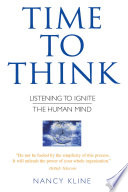

In 'Time to Think', Nancy Kline emphasizes the importance of dedicating time specifically for thinking. This concept revolves around creating an environment where individuals can reflect deeply on their thoughts without distractions. Kline argues that most people rush through their thoughts and decisions, often leading to subpar outcomes. By allocating uninterrupted time for thinking, individuals can explore complex ideas, solve problems more effectively, and foster creativity. The book provides various techniques for implementing thinking time, including setting aside regular intervals in personal and professional settings. This practice not only enhances individual productivity but also encourages collaborative thinking in groups, leading to more innovative solutions.
Continue readingKline introduces the concept of a 'Thinking Environment', which is a space that encourages open and honest dialogue. This environment is characterized by mutual respect, attention, and encouragement, where individuals feel safe to express their thoughts without fear of judgment. The author outlines ten components that contribute to a Thinking Environment, including attention, equality, ease, appreciation, and encouragement. By fostering these elements in conversations and meetings, leaders and teams can unlock deeper insights and more effective collaboration. This approach not only enhances the quality of discussions but also builds trust among team members, leading to a more cohesive working atmosphere.
Continue readingA critical aspect of creating a Thinking Environment is the ability to listen effectively. Kline emphasizes that listening is not merely about hearing words; it involves being fully present and engaged with the speaker. Active listening allows individuals to understand the nuances of what is being communicated, fostering a deeper connection and comprehension. Kline provides strategies for improving listening skills, such as minimizing distractions and focusing entirely on the speaker. By honing these skills, individuals can enhance their relationships, facilitate better discussions, and ultimately contribute to a more productive workplace culture.
Continue readingKline encourages readers to challenge their assumptions and preconceived notions. Often, individuals operate under a set of beliefs that can limit their thinking and creativity. By questioning these assumptions, individuals can open themselves up to new perspectives and ideas. The book provides practical exercises and thought experiments designed to help readers identify and confront their assumptions. This practice not only broadens one’s thinking but also fosters a culture of innovation and adaptability within organizations. By encouraging a mindset that embraces change and challenges the status quo, teams can become more resilient and forward-thinking.
Continue readingQuestions play a pivotal role in the thinking process, according to Kline. The book highlights how the right questions can lead to deeper insights and stimulate critical thinking. Kline suggests that rather than providing answers, leaders and facilitators should focus on asking thought-provoking questions that encourage exploration and discussion. This approach not only empowers individuals to think for themselves but also cultivates a sense of ownership over their ideas and solutions. The author provides examples of effective questions that can be used in various contexts, from team meetings to personal reflection, showcasing how they can drive meaningful conversations.
Continue readingKline advocates for the establishment of a culture that prioritizes thinking as a core value within organizations. This culture is characterized by an emphasis on reflection, collaboration, and continuous learning. By embedding thinking practices into the fabric of an organization, leaders can foster an environment where innovation thrives and employees feel valued for their contributions. The book discusses strategies for cultivating such a culture, including regular thinking sessions, training on listening and questioning techniques, and recognizing and rewarding thoughtful contributions. This cultural shift can lead to improved morale, increased engagement, and ultimately, better organizational performance.
Continue readingThe book concludes with insights into how effective thinking influences leadership. Kline posits that leaders who prioritize thinking not only enhance their own decision-making but also empower their teams to think critically and creatively. By modeling thoughtful behavior and creating a supportive environment, leaders can inspire their teams to engage in deeper thinking and take ownership of their roles. The author emphasizes that leadership is not just about making decisions but about cultivating an environment where everyone feels capable of contributing to the collective thought process. This shift in perspective can lead to more collaborative and effective leadership practices.
Continue reading